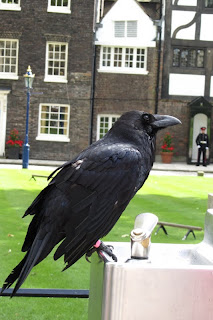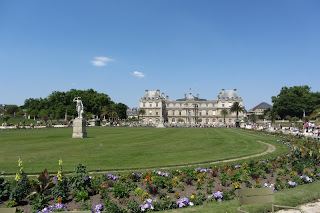When I knew that Michael and I would be stopping by London on our way back to the U.S., I knew that one of the days would be spent solely at the Tower of London. With such a rich history (it was founded in 1066) and the sheer size of the Tower complex, it was quite easy for Michael and I to spend the entire day of the 8th inside the Tower walls.
(The Tower from the outside.)
(Two Yeomen who still guard the tower, still subjecting guests to the many horrors of the tower.)
If these walls could talk, the story would be horrific, telling of doomed souls who entered the tower with their only exit being an escort up tower hill to the execution block. Though some of the Tower's prisoners did live to tell of their time there, the Tower has an infamous reputation and for good reason.
Walking over what was once a moat filled with lions, and continuing past the multitude of gates leading into the interior of the tower complex, one can not help but cringe. With the Bloody Tower and Traitor's Gate being the first things one sees upon entering, one can not help but think of the role this tower played in the loss of so much life.
The above picture is of the Traitor's gate. This water entrance into the Tower had actually been originally built as a mode of entry for the King, but came to be used as a mode of bringing prisoners of high importance into the prison. To enter in this way one must have passed under the Tower bridge, which displayed the heads of other 'traitors'. Needless to say it must have been an almost torturous way to enter a prison from which you might not leave alive. This gate acquired its colloquial name of the Traitor's Gate during the rule of the Tudors when it was extensively used. Queen Anne Boleyn, Sir Thomas More, and Queen Catherine Howard were amongst those forced to use this entrance.
During our visit at the tower an acting troop put on a dueling demonstration on the South lawn. Though it was slightly historically inaccurate since a duel ever having taken place within the tower is highly unlikely, it was fun to watch.
The entire time we were in the tower we were constantly learning. We both had known a significant amount about the Tower of London before going there (I had also been there before), but with a place such as this it seems impossible to not learn something new.
The above picture is of a Royal Chapel that had been constructed in the White Tower to provide the Monarch and the royal family with a private chapel. Due to her royal status, this is the place where Lady Jane Grey (the uncrowned Queen executed at the age of 16) spent the night before her execution praying. Like I have previously said one can not help but to feel a sense of despair when you are standing in such a place.
And if one had not already felt the anguish of the Tower's prisoners, go to the Tower Green where the Yeoman will tell you of the private execution spot of the privileged prisoners, such as Baron William Hastings, Queen Anne Boleyn, Countess Margaret, Queen Catherine Howard, Viscountess Jane Boleyn, Lady Jane Grey (the 9 days Queen), and Earl Robert Devereux. They were all buried in the Chapel Royal of St. Peter Ad Vincula, along with over one thousand other bodies of 'influencial' prisoners, many of which can not be identified.
The Tower of London is a must see, but be prepared for shivers down your spine as the Yeomen tell you the Tower's tales.
The Tower of London was our last major stop in London during our trip, and I must say it was a powerful conclusion. Michael and I really enjoyed London; Michael is already talking about what we will do when we come back to this great city.
Cheerio!!





























































